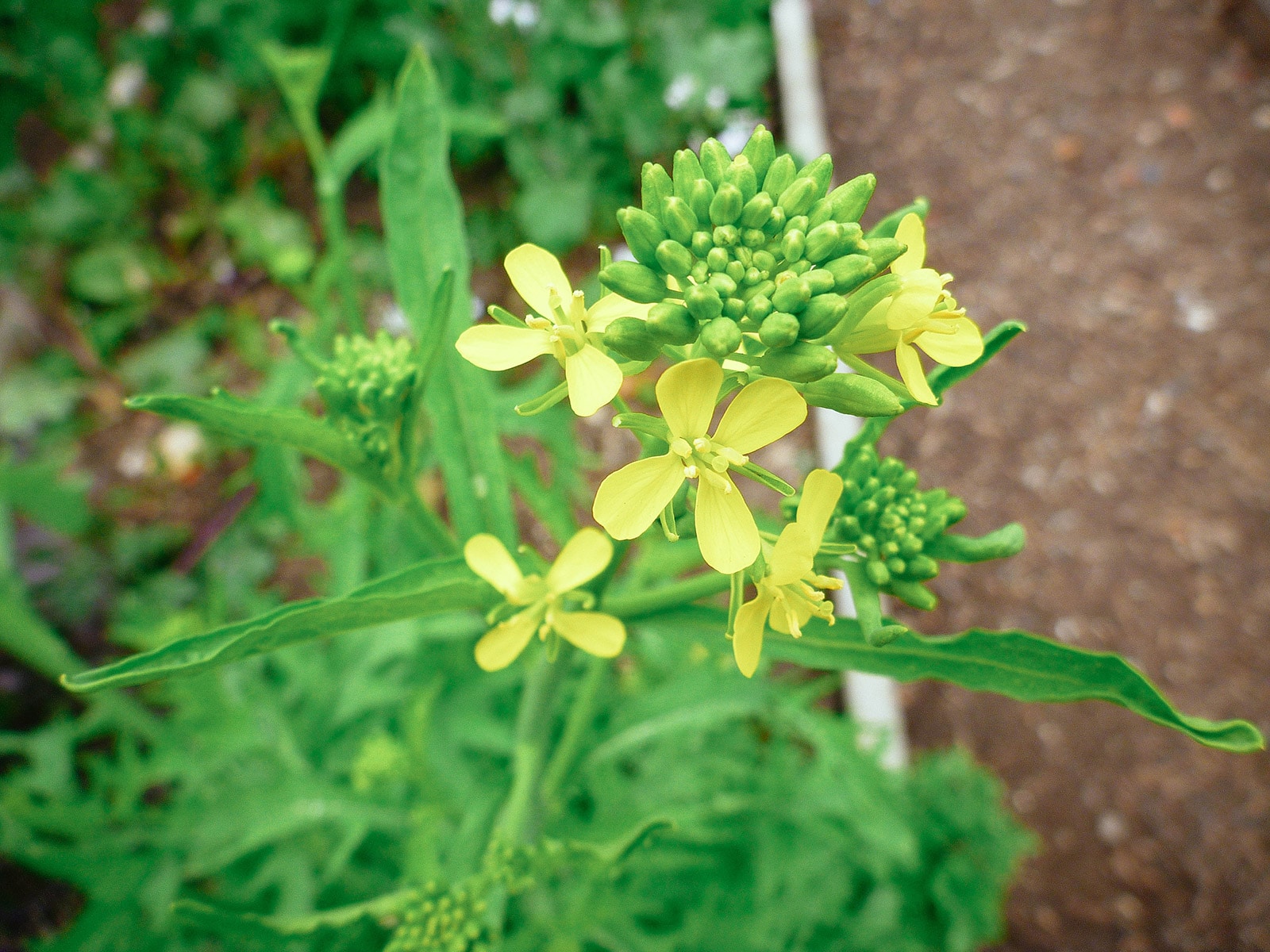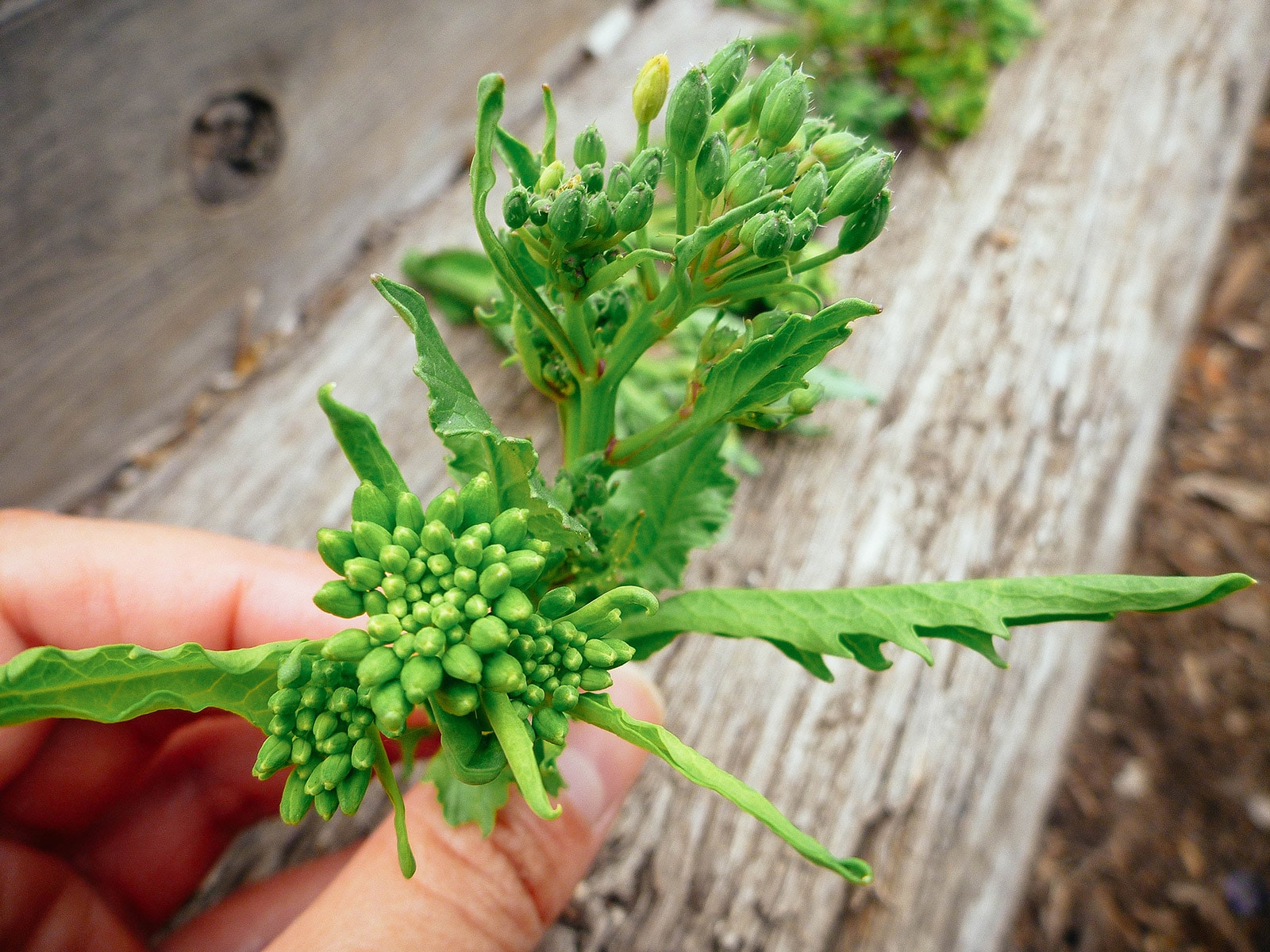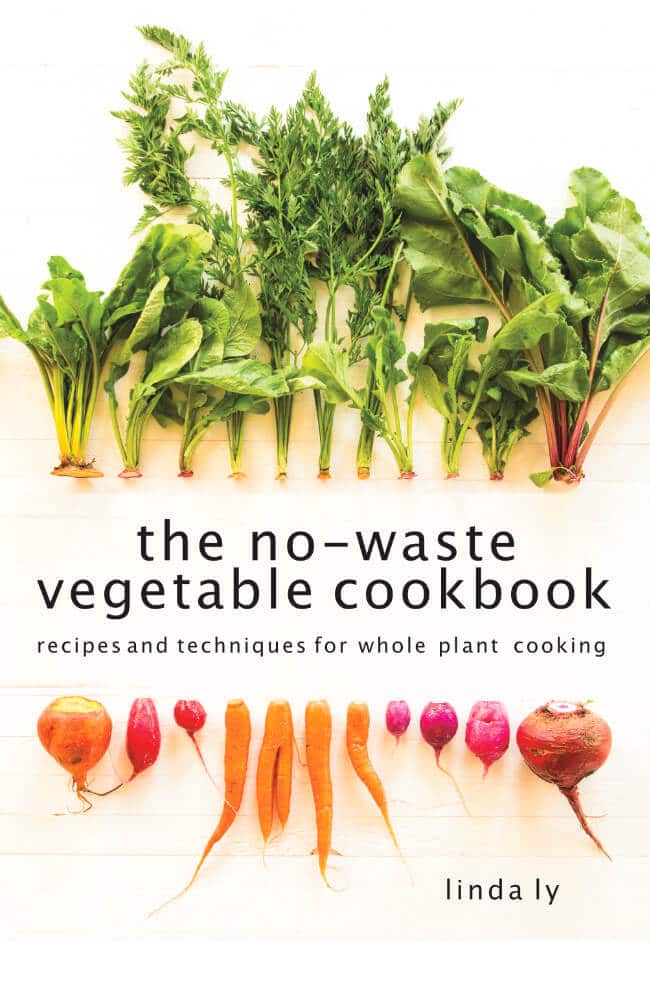We’re often told that once a brassica bolts, that signals the end of its life. Time to pull it up and toss it in the compost bin (or, if you’re like me and subscribe to the lazy gardening philosophy, you just cut it down and use the old foliage as mulch).
But to me, those first few kale buds (also known as kale flowers, kale florets, or kale raab) are the start of a new life—in the form of edible flowers that are surprisingly tender and sweet, especially if you’ve had a very cold winter, which brings out their sweetness more.
Did you know you can eat them? Dare I say, they’re sometimes even better than the rest of the plant! (And, you might have eaten other types of brassica flowers before and not realized it.)
What are kale buds?
Kale buds are simply the unopened flower heads on a mature kale plant. They appear when kale starts bolting at the first wave of heat in late spring to early summer.
Kale buds start out as tightly wrapped, green clusters of tender little flowers called florets, and this is when the texture is at its best. Once the yellow flowers bloom, they can get a bit tough and toothy after a while (though they’re still 100 percent edible).


Can you really eat kale flowers?
Absolutely, and you’d be missing out on a culinary delicacy if you didn’t!
If the concept of eating kale flowers seems strange to you, you’ve probably cooked with other forms of brassica buds and not even realized it.
Take broccoli raab, for example.
Raab (derived from rapa, Italian for turnip) is just a fancy word for the flowering tops of plants from the brassica family, such as kale, broccoli, mustard greens, and Chinese cabbage.
Broccoli raab (sometimes called rapini) is sold in supermarkets as bundles of stems with tight clusters of flower buds, some with tiny yellow blossoms. Gailan (also called Chinese broccoli, and available in Asian markets and specialty markets) is a culinary staple enjoyed for these little flower buds as well.


And did you know that a head of broccoli and head of cauliflower is actually just the flower bud of those plants?
Broccoli and cauliflower were selectively bred to produce huge amounts of flowers compared to other Brassica oleracea cultivars. The “heads,” or florets, are simply oversized versions of what should really be called broccoli buds and cauliflower buds—so this “unusual” part is more common than you think.
Read more: 11 Vegetables You Grow That You Didn’t Know You Could Eat
In fact, the brassica family is an incredibly diverse group of plants that were all bred from the same ancestor (wild mustard) to produce desirable characteristics in the crop. Kale was selected for its tender leaves; broccoli was bred to produce big, delicious florets and stems; kohlrabi was bred to make a swollen, crisp and juicy stem, and you may have noticed that it tastes a lot like a broccoli stem because, well… botanically it is!
There’s even a variety called asparagus kale that’s grown for its tasty, tender flower shoots, which can be snapped off in spring, blanched, and eaten like asparagus.
The point is, brassica plants make all kinds of edible parts beyond what you typically see in the store.
So then, you might be wondering, why doesn’t anyone ever sell kale florets?
It’s simply a matter of demand and the fact that eating kale florets has never been a part of American food culture. (Weird, but true.)
People buy kale for its leaves, since that’s the part they’re most familiar with, leaving farmers to move on to other crops long before kale has had a chance to flower. But if you grow your own kale at home, you get this bonus harvest at the end of the season that most people never experience!

When does kale start to flower?
Being a cold-hardy biennial, kale is best grown in the fall and survives winters down to USDA hardiness zone 7. (In my experience, it can keep going in zone 6 if given frost protection and plenty of winter mulch.) It spends its first season developing a strong root system and healthy head of leaves.
From late spring to early summer as the weather warms up, flower buds appear after an overwintered kale plant has completed its life cycle. A kale plant started in spring will also bolt (flower) once high summer temperatures arrive.
Before it sets seed, it sends up a flower stalk and the buds can (and should) be harvested for one final hurrah before the plant expires. You can even pinch the buds back to encourage more flower heads to form in the last couple weeks.
(I should add that you’ll usually only see flower buds on biennial kale, which most people grow as annuals. A few varieties of perennial kale do exist, and it’s a mixed bag as to which varieties will flower. Taunton Deane grows year-round and does not flower, for instance, while Daubenton perennial kale can.)
Once kale starts to flower, however, the quality of the leaves deteriorates. They become bitter and somewhat fibrous—though neither of this affects the flower buds, which stay sweet and tender.

Learn how to use every edible part of the vegetables you grow or buy (including kale buds!).
My book features recipes and techniques for wasting less food and getting more nutrition out of your plants—all while enjoying easy-to-prepare flavorful meals.
How to prepare kale florets
Harvesting and preparing kale florets is as easy as pinching off the stem (just below the bottom bud or flower) and giving the flowers a quick, light rinse in water. The stems are often soft enough to eat (even raw), so there’s no need to remove the flowers from the stem.
I like to cook the buds and flowers as a side dish, as they only need a simple dressing to bring out their flavor: some olive oil and garlic, sauteed with a squeeze of lemon. Toss it with a warm brown rice salad and a handful of wilted greens, and you have an easy weeknight meal.
You can also add kale raab to a stir-fry or pasta dish, or roast it with leeks and root vegetables. It also makes a nice garnish when used raw.
I used to sigh when I looked out my window at the end of the season and faced a bed of flowering kale, but now all I see is a delicious new crop!
Harvesting kale buds is a great way to get more out of your garden by doing less (after all, it means growing more food without planting more plants) so don’t be afraid to try it next time.

Common questions about kale buds
Are kale flowers poisonous?
Kale flowers are not poisonous. You can pick them as soon as they appear and eat them raw or cook them—both ways are delicious. The flavor of kale buds and kale flowers actually improves (and turns sweeter) if your garden was hit with a frost. (Though if you live in a climate that stays relatively mild in winter, they might seem a little bitter to some tastebuds.)
Should you cut the flowers off kale?
Once your kale plant is flowering, cutting off the flowers will not stop the process of bolting. Your plant is at the end of its life cycle and focusing its energy on producing seeds for the next generation of plants.
However, you can pinch off kale buds as they appear to extend the harvest period of these delicious blooms.
Are kale florets the same as broccolini?
No. Broccolini is a trademarked term for a patented vegetable hybrid, and it’s a cross of broccoli and gailan (Chinese broccoli).
Can you eat the flowers from other brassica plants?
Yes, you can—if you’re patient enough to wait for them to bolt. The flower buds on all Brassicas, including mustard, collards, cabbage, kohlrabi, brussels sprouts, mizuna, broccoli, cauliflower, and turnip, are 100 percent edible.

This post updated from an article that originally appeared on July 8, 2013.
View the Web Story on eating kale buds.
















I live in Iowa and my kale plants survived the winter. I have a new crop of new kale which is delicious. Just noticed it has bolted. I will make kale flowerettes for lunch! Thanks for ideas.
Linda,
I have an ornamental Kale that’s been through two winters having been brought indoors under grow lights. It’s flowered before but survived somehow, she’s a monstrous 5 headed beast standing several feet tall in a 15 gallon pot. It flowered the first winter I brought it inside but this past winter it did not. Do you have any tips on keeping it alive for many more years? Can these plants only flower once?
Thanks for the info!
It depends on the exact variety of ornamental kale you have. Most ornamental kales are biennials, but there are a few known to be perennials. If you have a biennial kale, then it should only flower once.
Can you eat them raw?
Yes you can! I sometimes put them in salads. (I prefer them cooked though, as I think that brings out the flavor more.)
Thank you for the great info! I’m a newbie and my kale is flowering. What should I do if I want to harvest seeds from it for another crop? I’ve been so proud of my kale and am sad to see it go. 🙁
Bolting may cause the leaves to be bitter, but it leaves the flowers sweet. Edible Kale Flower Buds http://t.co/VQDy5TQaQX #gardenchat
It’s like getting a bonus crop before the plant expires! Edible Kale Flower Buds http://t.co/YzqKdhf81W #gardenchat #gardening
Delicious! I eat many kids of flower buds from my garden. But I’ve always wondered (and maybe you can answer this question for me): are there any vegetables with flowers that you shouldn’t eat? (Rhubarb you’re not supposed to eat the leaves, but other than that?)
I’m not aware of any flowers that you shouldn’t eat (at least, not in what I grow at home)… but I typically only like flowers from my herbs (since they taste just like the herb leaves… onions and chives are my favorite) or sweeter flowers, like those from brassicas.
As for leaves that you shouldn’t eat, rhubarb is the only one I know of (the leaves contain high levels of oxalic acid, but as with most things, you’d have to eat a ton of rhubarb leaves to feel sick). I eat lots of “unconventional” leaves like carrot tops, fava bean leaves, radish leaves, pea shoots, young cucumber leaves, and I also steep tomato leaves in my tomato sauces for added flavor.
Ah, perfect, thank you!
When you steep the tomato leaves to add more flavour, does this mean that you then remove them later before serving, or do you leave them in to eat?
I remove them before serving. Here’s the recipe: http://gardenbetty.com/2013/08/spicy-minty-tomato-sauce-infused-with-tomato-leaves/
RT @theGardenBetty: The flowering tops of kale, broccoli, mustards and other brassicas are delicious. Edible Kale Flower Buds http://t.co/y…
Charlie Bourgeois liked this on Facebook.
RT @yardbutler RT @theGardenBetty: These clusters of buds are surprisingly tender and sweet! Edible Kale Flower Buds http://t.co/0SzM7GmMLL
RT @theGardenBetty: These clusters of buds are surprisingly tender and sweet! Edible Kale Flower Buds http://t.co/2eJxoh8Zp8 #gardenchat #g…
These clusters of buds are surprisingly tender and sweet! Edible Kale Flower Buds http://t.co/2eJxoh8Zp8 #gardenchat #gardening
Madeleine Grant liked this on Facebook.
Bolting is not the end of the plant’s life – it’s the start of a new life! Edible Kale Flower Buds http://t.co/4CTpekS4ru #gardenchat
Tracy Graves liked this on Facebook.
Shu-Hsien Lee liked this on Facebook.
Leanne Whitaker liked this on Facebook.
Diana Heffernan-Schrader liked this on Facebook.
Thu TranLe liked this on Facebook.
Yumm! Love them too!
Rebecca Ely liked this on Facebook.
Sarah Fawcett liked this on Facebook.
William Rutlege liked this on Facebook.
Esther Van de Klundert liked this on Facebook.
Angela Collins liked this on Facebook.
Edible Kale Flower Buds:
We’re often told that once a brassica bolts, that signals the end of its life. But t… http://t.co/385QwKxmMW
Blogged on Garden Betty: Edible Kale Flower Buds http://t.co/S4w7aRxjuf